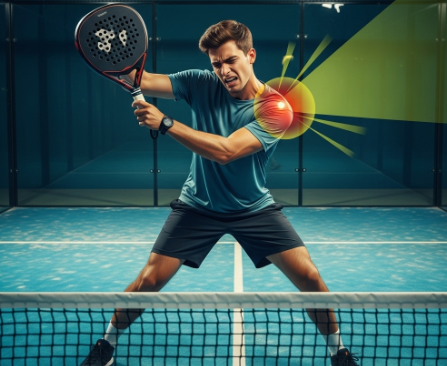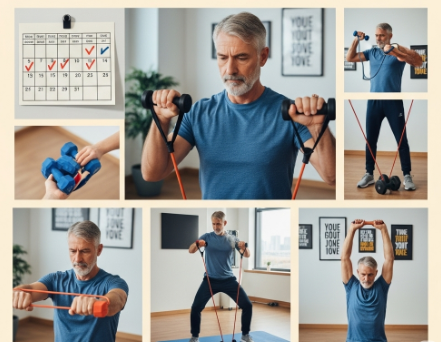Conquer Your Aches: The Midlifer's Guide to Rotator Cuff Rehab & Sports Comebacks
From Padel Passion to Crippling Pain: How I Conquered My Midlife Shoulder Injury
Conquer Your Aches: The Midlifer's Guide to Rotator Cuff Rehab & Sports Comebacks
By Naomi Greenaway, Deputy Editor, Telegraph Magazine
There’s a certain thrill in discovering a new sports obsession, particularly as a midlifer. For me, that thrill came with padel, a lively racket sport that blends elements of squash and tennis. Yet, this newfound passion inadvertently reignited an old shoulder niggle, escalating it into a full-blown, debilitating injury. What began with a simple “wrong angle” suitcase lift a decade ago—leaving me with a week in a sling and unpredictable flare-ups—ultimately forced me to confront my persistent shoulder pain head-on. Six months later, I’m thrilled to report that my sore shoulder is almost entirely healed. Here’s how I did it.
The Moment Padel Turned Painful
My padel journey began about five years ago during a Spanish holiday, but it wasn't until padel courts started popping up near my North London home this "school year" that my casual interest morphed into a weekly ritual. With the Lawn Tennis Association (LTA) reporting 800 padel courts across the UK, the sport's accessibility and sheer enjoyment factor meant I was often on court with family, friends, or for a fun date night. A low-level ache in my shoulder was present but easily ignored. That is, until one Sunday afternoon, attempting an enthusiastic smash, I missed the ball entirely and felt a familiar, sharp pull deep in my right shoulder.
| Conquer Your Aches: The Midlifer's Guide to Rotator Cuff Rehab & Sports Comebacks |
By Monday, the pain was excruciating, immobilizing my arm and making basic tasks like typing or driving impossible. While it did mean a temporary reprieve from kitchen duties, the severity of this flare-up sparked a new determination: to achieve full recovery, driven by my amateur padel aspirations.
Assembling My Dream Recovery Team
To tackle this, I enlisted a formidable team:
| Conquer Your Aches: The Midlifer's Guide to Rotator Cuff Rehab & Sports Comebacks |
Professor Tony Kochhar, also known as the Shoulder Doctor, a renowned shoulder consultant, confirmed my injury was common among midlife padel players.
Rob Madden, a physiotherapist whose impressive client list includes Anthony Joshua and GB Olympic skiers/snowboarders.
Monika Kolb, a personal trainer, was tasked with my long-term rehabilitation.
Professor Kochhar explained that active individuals over 40 are particularly susceptible to shoulder injuries due to sarcopenia, the age-related loss of muscle mass (around four percent per year). This, combined with midlifers taking up new, vigorous sports, creates a "perfect apex" for injury. Madden added that while the body can adapt to almost anything, it requires a "smooth, slow, and sensible" progression into new activities.
Understanding the Susceptible Shoulder
The rotator cuff, a group of muscles stabilizing the shoulder joint, is especially vulnerable. Unlike other joints primarily stabilized by ligaments, the shoulder's high mobility relies significantly on muscles for stability (around 50:50 with ligaments, compared to 10% in knees/ankles). This makes muscle degradation in midlife more impactful on shoulder function.
| Conquer Your Aches: The Midlifer's Guide to Rotator Cuff Rehab & Sports Comebacks |
My specific diagnosis, revealed by an ultrasound, was calcific tendonitis of the supraspinatus—a calcium build-up causing acute inflammation, tightness, and impaired function. A ten-minute "barbotage" procedure followed, using an ultrasound-guided needle to break down and suction out the calcium, concluding with a steroid injection to reduce inflammation. Thankfully, the procedure was uncomfortable rather than truly painful.
Professor Kochhar also clarified that persistent shoulder pain is often misdiagnosed as "frozen shoulder" by online searches. He states that the 18-24 month recovery advice for frozen shoulder is outdated. "With non-surgical treatment, good physio, and perhaps a steroid injection, 85-90 percent of patients are fully recovered in a matter of weeks," he assures. Any inflammation-reducing injection provides a crucial "window to try to rebalance and rehabilitate," which is where Madden's expertise came in.
My "Strength Homework": The Key to Recovery
Madden prescribed three isometric (static) exercises, performed every other day, targeting specific shoulder muscles:
| Conquer Your Aches: The Midlifer's Guide to Rotator Cuff Rehab & Sports Comebacks |
1. Band pull-aparts: Strengthening mid-back and posterior shoulder muscles (rhomboids and posterior deltoid) to improve posture.
2. Single-arm horizontal band rows: Engaging posterior shoulder and rhomboids.
3. Diagonal high-to-low reverse flies: Strengthening the posterior deltoid and rotator cuff.
These exercises collectively stabilize the shoulder capsule, which Madden likens to the "wetsuit of the joint." A healthy capsule is soft and pliable; injury can cause it to become stiff. The rehab aims to restore its flexibility and build necessary strength.
While these three exercises are broadly beneficial, Madden emphasized the need for individualization and consulting an expert. After six weeks of diligently completing these, "band pull-aparts" were swapped for dumbbell external rotations to further engage the shoulder joint, preparing me for padel.
The "Chicken Wing Test" and Long-Term Health
At my 12-week check-up, Professor Kochhar used his informal "chicken wing test" to assess recovery: holding upper arms out to the side, bent at 90 degrees at the elbow, then rotating forearms forward. "When your injured side is symmetrical with the healthy side, it means you’re fully recovered," he explained. My forearms aligned perfectly, earning me top marks and the green light for a summer of padel.
However, the hard work doesn't end there. Personal trainer Monika Kolb stresses that long-term shoulder health extends beyond just the shoulder itself. "Keeping your shoulders strong and healthy isn't just about working on mobility and strength in the shoulder itself, but in the upper back too," Kolb explained. "A strong back supports your shoulder by sharing the workload, so your body doesn’t rely on your shoulder as the default mover. This helps prevent irritation, overuse, and injury.”
| Conquer Your Aches: The Midlifer's Guide to Rotator Cuff Rehab & Sports Comebacks |
Kolb also highlighted the crucial role of posture. "Standing or sitting with poor posture—letting the upper back collapse or the shoulders round forward—can undo all your training." Her advice for lasting shoulder health: "Be aware of daily habits. Pay attention to how you stand and sit and don’t let your back get lazy. Practice holding yourself tall with an open chest and aligned spine. No amount of exercise will fix your shoulders if you’re constantly reinforcing bad posture throughout the day.”
Thanks to this comprehensive approach, my initial rehabilitation was a resounding success. While I may not be ready to throw a killer right hook like Anthony Joshua, I am definitely ready for a summer of padel.
Labels: Conquer Your Aches: The Midlifer's Guide to Rotator Cuff Rehab & Sports Comebacks








1 Comments:
---
This article promises a highly practical and empathetic guide for midlifers grappling with rotator cuff issues, particularly those eager to return to sports. By focusing on rehabilitation and offering clear strategies for overcoming common aches, it positions itself as an invaluable resource for active individuals seeking to maintain their lifestyle and achieve a successful comeback.
Post a Comment
If you have any doubt, please let me know
Subscribe to Post Comments [Atom]
<< Home